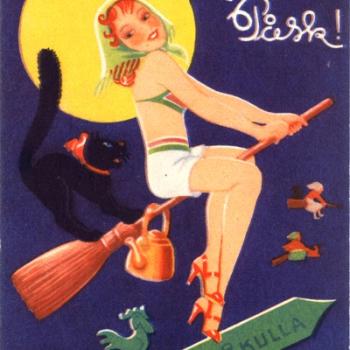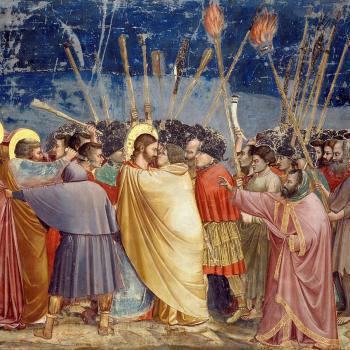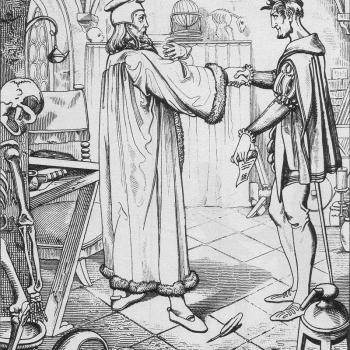In spite of all the evidence to the contrary, the witches’ staff, or ‘stang’ as we name it, is not phallic, but has the same position as the Tree of Life in your system. (Cochrane and Jones, 2002)
In his 1960s letter to the Qabalist Bill Gray, the pioneering witch magister Robert Cochrane makes the bold assertion that one of his most enduring symbols is not, as many might suspect, representative of the male reproductive organ, but is in fact a tree. Not just any tree, but the Qabalistic glyph supreme, the Tree of Life, further expounding upon this theme by identifying the knife and cord as the “…Father and Mother Pillars” respectively (Cochrane and Jones, 2002).
As the most prevalent contribution to modern witchcraft, the stang or forked staff must surely be Cochrane’s most enduring legacy. It is the tool par excellence, the premier symbol that modern traditional witches utilise in their practice, in myriad differing ways. Students of Cochrane’s work may even be able to recall some of the aspects of the stang to which he offers explanation, delineating some of the tool’s more subtle and complex associations. Indeed, in terms of fundamentals, the stang itself becomes a glyph of the entire system in much the same way as the Qabalist Tree of Life. It has been identified with the Old Man Himself, presiding over the rites as the substitute sacrifice of the sacred king, the totem which personifies the devil of the gather. However, it has a rather more archaic form to which we turn and it seems fitting that we should embark upon this journey nowhere else than in the beginning. Therefore, we turn back the folds of time to peel back the bark of our stang to reveal its rings and uncover its relevance to Modern Traditional Witchcraft.
Deep within the Cradle of Civilisation, the heirs of Cain set out domesticating grasses and structuring the chaotic world around them. Despite a brief quarrel with nomadic herding peoples, the agricultural society won out, affording as it did the tiers of class that included the warrior, necessary to protect the stored grain. Within the mythos of ancient Sumer and its hoary cities, we find the oldest narrative story recorded in human history – the Epic of Gilgamesh. Gilgamesh is an early Sumerian Warrior King who rules over the city of Uruk from the third Dynasty of Ur around 2100 BCE. Most modern translations of the oldest form of this text, which survived throughout the development of the Fertile Crescent into Babylonian and later translations of the myths, including some Biblical stories such as Noah, have purposefully placed a necessary short myth at its beginning, without which key aspects of the narrative that follows would make little sense (Kramer and Wolkstein, 1983). This early tellinghas been identified as a ‘genesis’ myth, fulfilling characteristics that are recognised by scholars in the field as pertaining to a myth used to explain an origin. Interestingly, this particular narrative emerges as highly influential upon the Biblical Genesis and must have found its way into the Judeo-Christian book following the Bablyonian Exile.
To give a brief description of the myth is necessary here to elucidate what follows. After the obligatory proclamations of creation, using the tell-tale signs of repetition to enforce the meaning, we are informed that this myth takes place in the ‘first days’. In all the other action that is taking place, a single tree is planted on the banks of the Euphrates river but is torn from its roots by the South Wind and carried away by the river, whereupon a woman comes across it and takes it to plant in her holy garden in the heart of the city of Uruk. This is no ordinary woman, but Innana, Queen of Heaven and Earth, patroness of Uruk and this is Her city.
The tree which Inanna plants, the Huluppu, was thought by leading scholar and translator Samuel Noah Kraner (1897 -1990) to be a willow, opening up the symbolism associated with this tree, including water and death to name but two. That Inanna’s intention was to use the tree, when fully grown, to fashion Her throne and bed tells us something of the relationship to the Goddess with Her Tree. It is to be the symbolic seat of Her power, the place from which she will hold council and from which authority and sacred law, the me, resides with its owner. Furthermore, the throne represents a fixed or planted station which is the seat of that high authority and law, unmoving, but passing its rite by virtue to the one to which it belongs. The bed, by contrast, is representative of the throne but as a symbol of intimacy, vulnerability, oneiric vision and, most relevant to Inanna, sexual energies and rites of passage associated with the feminine. Hewing a bed from a tree is a common motif into the Classical period, where we see Odysseus, the epitome of tricksters, and Penelope’s bed carved out of an olive tree. Symbolically, we can regard the fashioning of the tree, then, to be at its highest when it becomes the equivalent of the throne, but seen through the eyes as a seat of the Hieros Gamos.
We can begin to see that this Huluppu tree is not any old tree, perhaps the oldest of trees, and representative of a World Tree, a cosmological map through branches and roots, between heaven and earth, over which Inanna is Queen. That this tree would fashion for Inanna the planted seat of her authority under the sacred law, as well as the bed in which she consummates Her divine marriages, thereby conveying the Virtue of Her authority, between the ethereal and manifest, Kether and Malkuth, and thus epitomises the later Qabalist and Hermetic Tree, is suggestive that we must regard this tree as representative of Inanna Herself.
Indeed, the Tree is more than a simple spiritual embodiment of Inanna and Her lawful authority as Queen Goddess and Divine Feminine, it is possessed of the very forces which compose the complete cosmological map as “…part of the three kingdoms: the underworld of Ereshkigal, the earth of Enlil, and the heavens of An” (Kramer and Wolkstein, 1983). So we can already see the depth and complexity that this World Tree assumes.
But the myth goes further, and in so doing provides the earliest extant textual evidence for the age of the World Tree myths that permeate societies of the past, even providing Qabbalah with the schematic and mythopoetic geography with which to explore and expand.
Then a serpent who could not be charmed
Made its nest in the roots of the huluppu tree.
The Anzu-bird set his young in the branches of the tree.
And the dark maid Lilith built her home in the trunk. (Kramer and Wolkstein, 1983)
The comparison with this structure now with myriad World Trees from cultures and times spanning the globe would be a study in itself. Needless to say, one such that immediately leaps out is the Norse Yggdrasil. It is interesting to note, however, that the spirit at the heart of the tree itself, however, is once again feminine. This proto-World Tree is a cosmological device and, as such, it is distinctly feminine, and sexually so.
The folklorist Diane Wolkstein (1942 – 2013) discusses some of these symbolic themes in Inanna: Queen of Heaven and Earth, an anthology of Sumerian myths and hymns to Inanna brought together by Samual Noah Kramer. In her essay which expounds upon the theme of the huluppu tree, whereby we see the triune beasts which take up residence in the tree as analogous to the ripening of Inanna’s sexuality and maturing into womanhood, and the world and role which she must possess (Kramer and Wolkstein, 1983) . Indeed, it is not difficult to discern the euphemisms when the young Inanna invites the hero, her human brother, Gilgamesh ‘into her garden’ to rid her of the uncivilised regenerative metaphors which have settled within. If the tree itself is synonymous with Inanna, then we must wee these creatures not only as three in one, but all within. Thus, the regenerative force of change that is represented by the serpent is aroused within her roots, the Anzu bird, part lion and part eagle (thus conjoining heaven and earth) which would steal the sacred me, the laws and wisdom of civilisation, for its own selfish purposes and the dark maid Lilith who would come to preside over the liminal moments of womanhood, from first sexual encounters to childbirth, demonised in Jewish superstition, are all aspects of an adolescent Inanna.
Hopefully, this brief synopsis of some of the key elements in this rich, yet brief, myth have alluded to some of the characteristics of the stang in Modern Traditional Witchcraft. Indeed, it is the World Tree in its most essential form, representing the entire cosmology, a glyph of the compass in fact, with the forked lunar crown at its head, the crossed arrows of Neith indicating fate and movement in the quaternary manifest world, garlanded with the fruit of the season, the sickle or serpent at the foot. The mythos is present within the stang, and its residing spirit is most assuredly feminine, it belongs rightly to Inanna.
 And now we come to one of the pertinent mysteries of the stang within traditional witchcraft. The huluppu tree of Inanna is rid of its resident negative aspects when the hero, Gilgamesh, takes his bronze axe, a civilising masculine symbol, and strikes the serpent, causing the Anzu to fly away to the mountains and the maid Lilith to smash Her way to the wild places. Gilgamesh then makes for Inanna her throne and bed and the Queen takes up Her position of power as the residing spirit of the World Tree, anima mundi. Gilgamesh himself is awarded gifts, which he later loses, form the crown and the roots of the tree. The reconciling of opposites is evident throughout the story, with the conjunction of heaven and earth, masculine and feminine, the key theme throughout.
And now we come to one of the pertinent mysteries of the stang within traditional witchcraft. The huluppu tree of Inanna is rid of its resident negative aspects when the hero, Gilgamesh, takes his bronze axe, a civilising masculine symbol, and strikes the serpent, causing the Anzu to fly away to the mountains and the maid Lilith to smash Her way to the wild places. Gilgamesh then makes for Inanna her throne and bed and the Queen takes up Her position of power as the residing spirit of the World Tree, anima mundi. Gilgamesh himself is awarded gifts, which he later loses, form the crown and the roots of the tree. The reconciling of opposites is evident throughout the story, with the conjunction of heaven and earth, masculine and feminine, the key theme throughout.
This tree and its myth contain the revelation of knowledge of life and death, with recurring themes and regeneration in the symbolism of the serpent, the tree and its potential for life gifing, as well as the young being nurtured in its branches.
The tree, which was born from the confrontation of life’s opposing forces, is now shared between Inanna and Gilgamesh; woman and man, Goddess and mortal. Contact with the tree brings Sumerian man and woman to a closer understanding of life’s forces. (Kramer and Wolkstein, 1983)
One of the most relevant facets of the myth now take place, mostly unobserved by the casual observer, but of significance to Cochrane, perhaps, and his works. The stang, as the huluppu tree, is the axis mundi, and its virtue is held within as the Queen of Heaven and Earth and held in turn, therefore, by the office of the Maid in Modern Traditional Witchcraft. As with Inanna, this Virtue resides within the representation of the tree and is only passed to Her King by rite of challenge and through the hieros gamos. Here we can see the myth is highly reminiscent of George Frazer’s Golden Bough episode of the Rex Nemorensis, who tends to the tree of Diana until a challenger defeats him and assumes the role.Gilgamesh, we learn, attends to Inanna and relieves Her of Her troubles, and the sexual connotation is perhaps evident as suggested by some (Kramer and Wolkstein, 1983) , and is awarded with the Kingship of Her city. To him, the people owe absolute duty under law. To Her, they offer themselves up completely as it is through Her that he reigns. Similarly, the stang is rightly the Maid’s wand of office, and she may entrust her chosen magister to enact the duty and rites of the people through her virtue held by this important tool.

Cochrane, R. and Jones, E. J. (2002) The Robert Cochrane Letters: An Insight into Modern Traditional Witchcraft. 1st edn. Edited by M. Howard. Capall Bann Publishing.
Kramer, S. N. and Wolkstein, D. (1983) Inanna: Queen of Heaven and Earth. 1st edn. Harper & Row Publishers.













